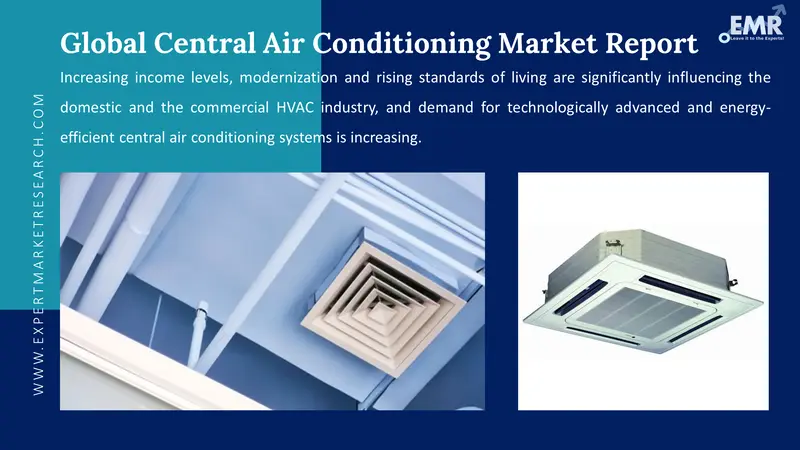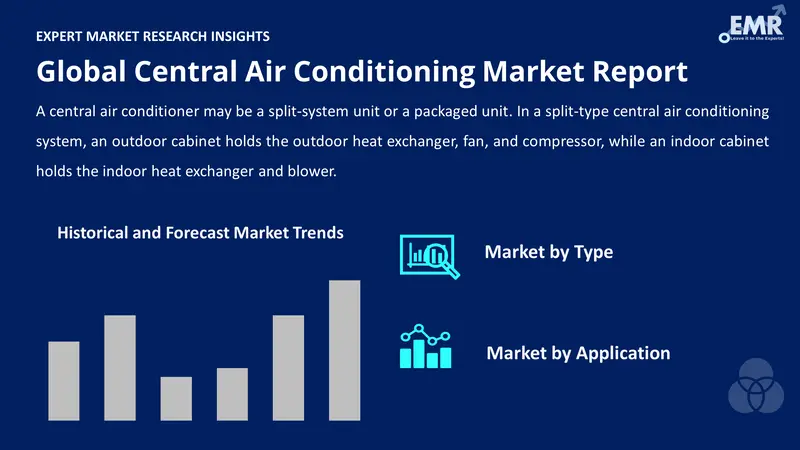
Consumer Insights
Uncover trends and behaviors shaping consumer choices today
Procurement Insights
Optimize your sourcing strategy with key market data
Industry Stats
Stay ahead with the latest trends and market analysis.
The global central air conditioning market is expected to grow at a CAGR of 6.70% during the period 2026-2035. The market is expected to be driven by changing climatic conditions and growing demand from the commercial construction sector. North America, Europe and Asia are expected to be key markets.
Base Year
Historical Period
Forecast Period
Compound Annual Growth Rate
6.7%
2026-2035
*this image is indicative*
Increasing income levels, modernization and rising standards of living are significantly influencing the domestic and the commercial HVAC industry, and demand for technologically advanced and energy-efficient central air conditioning systems is increasing. In the commercial construction industry, the selection of an appropriate central air conditioning system is important as a wrong selection could increase initial or running costs of the system and decrease comfort and indoor air quality.
Central air conditioning is a system wherein air is cooled at a central location and distributed to and from rooms by one or several fans and ductwork. In central air conditioning systems, cool air is circulated through an arrangement of supply and return conduits. Supply channels and registers (i.e., cavities in walls, floors, or ceilings covered with grills) transfer cool air from the air conditioner to the house. As this cooled air warms while circulating through the house, it drifts back to the central air conditioner through return ducts and registers. Central air conditioners are more efficient, quiet, easy to operate and convenient than room air conditioners. A central air conditioning system is generally used to cool houses, factories, big buildings, offices, hotels, etc. For big areas to cool, central air conditioning is probably the most appropriate alternative.
A central air conditioner may be a split-system unit or a packaged unit. In a split-type central air conditioning system, an outdoor cabinet holds the outdoor heat exchanger, fan, and compressor, while an indoor cabinet holds the indoor heat exchanger and blower. In several split-system air conditioners, the indoor cabinet may hold a furnace or an indoor heat exchanger of a heat pump. If a house already has a furnace but not an air conditioner, a split-system may be an economical alternative.
In a packaged system, the heat exchangers, compressor, fan, and blower are held in a cabinet; the cabinet is generally kept on a roof or on a concrete slab next to the foundation of the house. This kind of air conditioning system is also employed in small commercial buildings. Supply and return ducts extend from the interiors through the structure’s exterior wall or roof to link with the packaged air conditioner. Packaged air conditioning systems generally include electric heating coils or a natural gas furnace. The grouping of air conditioner and central heater does away with the need for a separate furnace.

Read more about this report - REQUEST FREE SAMPLE COPY IN PDF
Several leading companies offer efficient solutions that deliver high performance. These include American Standard, Heil, Trane, Bryant, Goodman, Amana, Carrier, York, Lennox, Rheem, etc. Each brand offers unique central air conditioning features and characteristics such as high energy efficiency, silent functioning, greater reliability, attractive warranty cover, smart home options, extensive range, cost-efficiency, good customer care, etc.
However, higher costs associated with some solutions might hinder market growth.

Read more about this report - REQUEST FREE SAMPLE COPY IN PDF
The EMR’s report titled “Central Air Conditioning Market Report and Forecast 2026-2035” offers a detailed analysis of the market based on the following segments:
Market Breakup by Type
Market Breakup by Application
Market Breakup by Region
The report presents a detailed analysis of the following key players in the market, looking into their capacity, and latest developments like capacity expansions, plant turnarounds, and mergers and acquisitions:
The EMR report gives an in-depth insight into the industry by providing a SWOT analysis as well as an analysis of Porter’s Five Forces model.




*While we strive to always give you current and accurate information, the numbers depicted on the website are indicative and may differ from the actual numbers in the main report. At Expert Market Research, we aim to bring you the latest insights and trends in the market. Using our analyses and forecasts, stakeholders can understand the market dynamics, navigate challenges, and capitalize on opportunities to make data-driven strategic decisions.*
Get in touch with us for a customized solution tailored to your unique requirements and save upto 35%!
The global central air conditioning market is projected to grow at a CAGR of 6.70% between 2026 and 2035.
The major drivers of the market include the increasing income levels, modernisation, rising standards of living, technologically advanced concepts, use of artificial intelligence and the internet of things (IoT), and high investment in the research and development of efficient products.
The changing climatic conditions and growing demand from the commercial construction sector are the key industry trends propelling the market's growth.
The major regions in the industry are North America, Latin America, the Middle East and Africa, Europe, and the Asia Pacific.
Based on type, the market is divided into split system, packaged unit, and rooftop system.
The major applications are residential and commercial.
The major players in the industry are Daikin Industries Ltd., Carrier Corporation, Lennox International Inc., Blue Star Limited, and Fujitsu General Limited, among others.
Explore our key highlights of the report and gain a concise overview of key findings, trends, and actionable insights that will empower your strategic decisions.
| REPORT FEATURES | DETAILS |
| Base Year | 2025 |
| Historical Period | 2019-2025 |
| Forecast Period | 2026-2035 |
| Scope of the Report |
Historical and Forecast Trends, Industry Drivers and Constraints, Historical and Forecast Market Analysis by Segment:
|
| Breakup by Type |
|
| Breakup by Application |
|
| Breakup by Region |
|
| Market Dynamics |
|
| Competitive Landscape |
|
| Companies Covered |
|
| Report Price and Purchase Option | Explore our purchase options that are best suited to your resources and industry needs. |
| Delivery Format | Delivered as an attached PDF and Excel through email, with an option of receiving an editable PPT, according to the purchase option. |
Datasheet
One User
USD 2,499
USD 2,249
tax inclusive*
Single User License
One User
USD 3,999
USD 3,599
tax inclusive*
Five User License
Five User
USD 4,999
USD 4,249
tax inclusive*
Corporate License
Unlimited Users
USD 5,999
USD 5,099
tax inclusive*
*Please note that the prices mentioned below are starting prices for each bundle type. Kindly contact our team for further details.*
Flash Bundle
Small Business Bundle
Growth Bundle
Enterprise Bundle
*Please note that the prices mentioned below are starting prices for each bundle type. Kindly contact our team for further details.*
Flash Bundle
Number of Reports: 3
20%
tax inclusive*
Small Business Bundle
Number of Reports: 5
25%
tax inclusive*
Growth Bundle
Number of Reports: 8
30%
tax inclusive*
Enterprise Bundle
Number of Reports: 10
35%
tax inclusive*
How To Order

Select License Type
Choose the right license for your needs and access rights.

Click on ‘Buy Now’
Add the report to your cart with one click and proceed to register.

Select Mode of Payment
Choose a payment option for a secure checkout. You will be redirected accordingly.
Gain insights to stay ahead and seize opportunities.

Get insights & trends for a competitive edge.

Track prices with detailed trend reports.

Analyse trade data for supply chain insights.

Leverage cost reports for smart savings

Enhance supply chain with partnerships.

Connect For More Information
Our expert team of analysts will offer full support and resolve any queries regarding the report, before and after the purchase.
Our expert team of analysts will offer full support and resolve any queries regarding the report, before and after the purchase.
We employ meticulous research methods, blending advanced analytics and expert insights to deliver accurate, actionable industry intelligence, staying ahead of competitors.
Our skilled analysts offer unparalleled competitive advantage with detailed insights on current and emerging markets, ensuring your strategic edge.
We offer an in-depth yet simplified presentation of industry insights and analysis to meet your specific requirements effectively.
Share